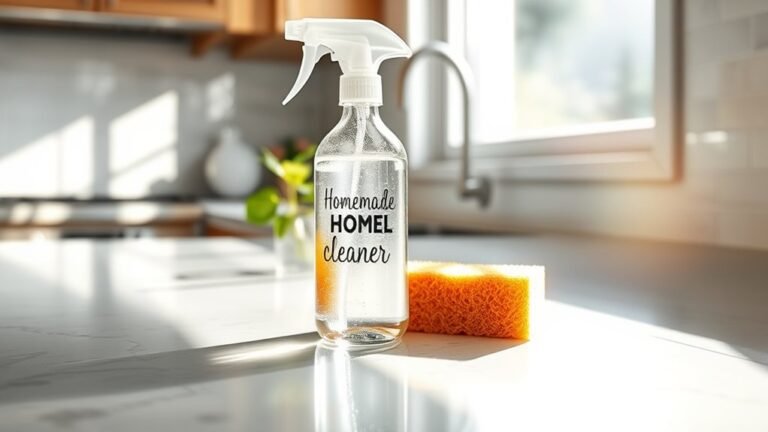How to Clean Your Mirror in 10 Minutes
To clean your mirror in 10 minutes, start by gathering microfiber cloths and an eco-friendly cleaner like a water-vinegar mix. Wipe off dust gently with a soft cloth, then spray the cleaner evenly from 6-8 inches away. Use a squeegee in smooth, overlapping strokes from top to bottom for a streak-free finish. Don’t forget to clean edges with a cotton swab, then buff with a dry cloth for extra shine. There’s more to discover for effortless sparkling mirrors.
Gather Your Cleaning Supplies

Before you start cleaning your mirror, make sure you’ve gathered all the necessary supplies. Having the right cleaning tools at your fingertips frees you from unnecessary trips and wasted time. You’ll want a microfiber cloth, which is gentle yet effective, avoiding scratches. Next, choose your cleaning solutions carefully—opt for something streak-free and eco-friendly to keep both your mirror and conscience clear. Avoid abrasive chemicals that could damage the glass or frame. A spray bottle filled with a water-vinegar mix works wonders and gives you control over the cleaning process. By assembling your supplies wisely, you set yourself up for a smooth, efficient cleaning session. This simple preparation lets you enjoy your spotless mirror without hassle, embracing the freedom that comes with a clear reflection and a clutter-free routine.
Remove Dust and Loose Debris
Before you start wiping your mirror, make sure to remove any dust and loose debris first. Use a soft cloth or a gentle brush designed for delicate surfaces to avoid scratches. Taking your time with these gentle dust removal techniques will make the cleaning process much easier.
Use a Soft Cloth
You’ll usually want to start by gently wiping the mirror with a soft cloth to remove dust and loose debris. Choosing the right soft cloth type is key—microfiber, cotton, or even bamboo-based cleaning cloth materials work great because they’re gentle and won’t scratch your mirror’s surface. Avoid anything rough or abrasive that could leave marks. When you pick your cloth, make sure it’s clean and dry; this helps trap dust instead of spreading it around. Using a soft cloth lets you maintain your mirror’s shine while giving you the freedom to clean quickly and efficiently. Keep a few of these cloths handy so you’re always prepared to give your mirror a flawless finish without any hassle.
Choose the Right Brush
Selecting the right brush is essential for effectively removing dust and loose debris from your mirror without causing scratches. When choosing brush types, look for ones with soft bristles designed specifically for delicate surfaces. Natural bristle brushes or those labeled as ultra-soft work best, as their bristle softness guarantees they glide gently across the mirror’s surface, lifting dust without abrasion. Avoid stiff or synthetic brushes, which can leave marks or push debris into tiny crevices. Having the freedom to pick the perfect brush means your cleaning process becomes quicker and safer, protecting your mirror’s clarity. Keep your focus on bristle softness and appropriate brush types, and you’ll maintain a spotless mirror with minimal effort and no risk of damage.
Gentle Dust Removal Techniques
Although dust might seem harmless, removing it gently is essential to avoid scratching your mirror’s surface. Using the right dusting techniques and gentle tools keeps your mirror spotless without damage. Here’s how you can do it quickly and safely:
- Use a soft microfiber cloth to lift dust without grinding it into the glass.
- Employ a feather duster or a soft-bristled brush for corners and edges.
- Avoid spraying liquids directly onto the mirror to prevent streaks.
- Lightly tap or shake out dust from cloths or brushes before use to avoid dirt buildup.
Choose the Right Cleaning Solution
When it comes to cleaning your mirror, picking the right solution is key to avoiding streaks and damage. You want something effective yet gentle. A vinegar solution is a popular DIY choice—it’s natural, budget-friendly, and streak-free. Commercial cleaners work fast but sometimes contain harsh chemicals that may harm your mirror’s edges over time. Choose what fits your style and values.
| Solution Type | Pros | Cons |
|---|---|---|
| Vinegar Solution | Natural, streak-free | Strong smell |
| Commercial Cleaners | Quick, convenient | May contain chemicals |
| Water + Mild Soap | Gentle, safe | Might leave residue |
Pick your favorite, then move on to prepping your cloths for a flawless finish.
Prepare Your Cleaning Cloths

Before you start cleaning, make sure you have lint-free cloths on hand to avoid streaks and fibers on your mirror. It’s helpful to gather a few cloths so you can switch to a dry one when needed. This way, you’ll keep your mirror spotless and clear throughout the process.
Choose Lint-Free Materials
A key step in cleaning your mirror effectively is choosing lint-free materials for your cloths. Using the right fabric types guarantees you won’t leave behind pesky fibers that ruin your streak-free goal. Here are some top lint free options to evaluate:
- Microfiber cloths – Soft, highly absorbent, and perfect for picking up dust without scratching.
- Cotton flannel – Smooth and gentle, great for delicate surfaces.
- Chamois leather – Naturally lint-free and excellent for polishing.
- Linen cloths – Durable and less likely to shed fibers.
Gather Multiple Cloths
Since mirrors require different stages of cleaning, you’ll want to gather multiple cloths to handle dusting, wiping, and polishing without spreading dirt or streaks. Start by selecting cloth types that suit each step: a soft microfiber cloth for dusting, a slightly dampened one for wiping away smudges, and a dry, lint-free cloth for the final polish. Using separate cloths prevents cross-contamination and keeps your mirror sparkling. Remember, adjusting your cleaning frequency based on how often your mirror gets dirty helps maintain its clarity effortlessly. By preparing multiple cloths ahead of time, you free yourself from the hassle of stopping midway, letting you enjoy a quick, efficient cleaning that fits your pace and lifestyle.
Apply the Cleaner to the Mirror
Spray your chosen cleaner evenly across the mirror’s surface, making sure to cover all areas without soaking the edges. Different cleaning solutions work better depending on your mirror types, so pick one that suits your glass and frame. Here’s how to apply it right:
Evenly spray cleaner on the mirror surface, avoiding edges, and choose a solution that suits your glass and frame.
- Hold the spray bottle about 6-8 inches away to avoid drips.
- Lightly mist the entire mirror surface, avoiding excess liquid near wooden or painted edges.
- Focus on spots with fingerprints or smudges, but don’t oversaturate.
- Let the cleaner sit for a few seconds to loosen dirt without running down.
Wipe in a Circular Motion

When you wipe your mirror in a circular motion, it helps spread the cleaner evenly and prevents streaks. This technique guarantees every spot gets attention without missing any areas. You’ll find your mirror looks clearer and streak-free with just a few smooth circles.
Benefits of Circular Motions
Although it might seem like a small detail, wiping your mirror in a circular motion can make a big difference in how clean and streak-free it looks. This technique boosts cleaning efficiency and reveals several circular motion benefits you’ll appreciate.
Here’s why you should embrace this method:
- It evenly distributes pressure, preventing missed spots.
- Circular motions break down grime gently without scratching.
- You reduce streaks by blending cleaning solution across the surface.
- It speeds up the process, so you’re free to enjoy a sparkling mirror faster.
Techniques for Even Coverage
Mastering just a few simple techniques can assure you achieve even coverage when cleaning your mirror using circular motions. Start by applying your cleaning solution sparingly and move your cloth in smooth, overlapping circles. This method assures every inch is wiped evenly, reducing the chance of missed spots or streaks. By doing this, you not only get a spotless shine but also aid in mirror streaks prevention, keeping your mirror flawless longer. Remember, adjusting your cleaning frequency tips based on your environment helps maintain this clarity without overdoing it. Stick to a routine that fits your lifestyle—too frequent can cause buildup, too sparse leads to grime. This way, your mirror stays fresh, and you enjoy the freedom of a crystal-clear reflection every day.
Use a Squeegee for Streak-Free Finish
A squeegee is one of the simplest tools you can use to achieve a streak-free finish on your mirror. By mastering some key squeegee techniques, you’ll enjoy quick, effective streak prevention that leaves your mirror shining brilliantly. Here’s how to get started:
- Start at the top corner, pulling the squeegee straight down in one smooth motion.
- Wipe the blade with a clean cloth after each pass to avoid smudges.
- Overlap each stroke slightly to guarantee full coverage without leaving streaks.
- Finish by running the squeegee horizontally along the bottom edge for a clean line.
Using a squeegee frees you from endless wiping, giving you sparkling mirrors with minimal effort and maximum freedom.
Pay Attention to Edges and Corners
Two small areas often overlooked when cleaning mirrors are the edges and corners, but they’re key to achieving a truly spotless finish. For effective edge detailing and corner cleaning, use a cotton swab or a soft brush dipped in your cleaning solution to reach those tight spots. Don’t rush—these areas trap dust and grime that spoil your mirror’s pristine look.
| Area | Tool Needed | Tip |
|---|---|---|
| Edges | Microfiber cloth | Wipe gently to avoid streaks |
| Corners | Cotton swab | Use for precise cleaning |
| Frame Junction | Soft brush | Loosen trapped dirt |
| Bottom Edge | Sponge corner | Absorb excess moisture |
| Top Edge | Lint-free cloth | Finish with a dry wipe |
Paying close attention here frees your mirror from hidden smudges.
Buff the Mirror for Extra Shine
Once you’ve carefully cleaned the edges and corners, giving your mirror a final buff can make all the difference. This step releases shine enhancement that truly frees your mirror’s brilliance. Try these simple buffing techniques to elevate your mirror’s gleam:
- Use a dry microfiber cloth to gently rub the surface in circular motions.
- Apply light pressure—too much can leave streaks or damage the glass.
- Focus on problem areas with stubborn spots for extra attention.
- Finish with quick, sweeping strokes to create a smooth, reflective finish.
Maintain Your Mirror’s Cleanliness Regularly
Keeping your mirror spotless doesn’t have to be a chore if you make cleaning a regular habit. By embracing regular maintenance, you free yourself from the hassle of stubborn stains and streaks piling up. A quick wipe-down every few days with a microfiber cloth can keep dust and smudges at bay, making full cleanings less frequent and less time-consuming. Consistent mirror care guarantees you always have a clear reflection, supporting your daily routine without interruption. Plus, it extends the lifespan of your mirror by preventing buildup that could damage the surface over time. So, set a simple schedule that fits your lifestyle, and enjoy the freedom of a brilliantly clean mirror without the stress of last-minute scrubbing. Regular upkeep truly keeps your space shining effortlessly.
Frequently Asked Questions
Can I Use Vinegar to Clean Mirrors Safely?
You can definitely use vinegar to clean mirrors safely, and it’s a smart choice if you want to keep things natural. Vinegar benefits include cutting through grime and leaving your glass streak-free, making mirror maintenance easier and more eco-friendly. Just mix equal parts vinegar and water in a spray bottle, spray your mirror, then wipe with a microfiber cloth. You’ll enjoy a clear reflection without harsh chemicals, giving you freedom from toxins.
How Often Should I Deep Clean My Mirror?
You should consider your mirror maintenance routine based on how quickly it gets dirty. For most, a deep clean every two to four weeks works well to keep it sparkling. Adjust your cleaning frequency if you notice smudges or buildup sooner—you’re free to tailor it to your lifestyle. Regular upkeep prevents grime from settling, making each deep clean easier and helping your mirror stay crystal clear, reflecting your space perfectly.
What Causes Foggy Mirrors in Bathrooms?
Foggy mirrors in your bathroom happen because of bathroom humidity. When you take hot showers or baths, the warm moisture in the air condenses on the cooler mirror surface, creating that foggy layer. To keep your mirror clear, you’ll want to reduce humidity by ventilating the space—like opening a window or using an exhaust fan. This way, you can enjoy a clearer reflection without feeling trapped by constant fog.
Are Paper Towels Effective for Mirror Cleaning?
Did you know that 90% of streaks on mirrors come from improper cleaning tools? When it comes to mirror cleaning, paper towels might seem handy, but they often leave lint and streaks behind. You’ll get much better results using microfiber cloths combined with streak free solutions—they’re designed to lift grime without scratching or smearing. If you want your mirror crystal clear and hassle-free, ditch the paper towels and embrace microfiber for freedom from streaks.
Can Cleaning Products Damage Mirror Backing?
Yes, some cleaning products can damage your mirror’s backing, so it’s smart to follow mirror maintenance tips. Avoid harsh chemicals like ammonia or bleach, which can eat away at the reflective layer behind the glass. Instead, stick to gentle cleaners or make your own with water and vinegar for safe mirror maintenance. These cleaning product recommendations help keep your mirror looking great without risking damage, giving you the freedom to clean worry-free.






